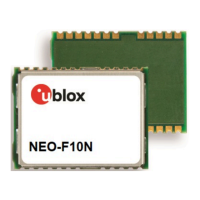NEO-F10N-Integration manual
Figure 6: Antenna supply network
4.3 Layout
GNSS signals on the surface of the earth have a very low signal strength and are about 15 dB
below the thermal noise floor. When integrating a GNSS receiver into a PCB, the placement of the
components, as well as grounding, shielding, and interference from other digital devices are crucial
issues that need to be considered very carefully.
An important factor in achieving high GNSS performance is the placement of the receiver with
respect to other components on the PCB.
To minimize signal loss on the RF connection from the antenna to the receiver input and to avoid
possible coupled interference, the connection to the antenna must be kept short while keeping some
distance from the antenna to other electronic components.
The RF section should not be subject to noisy digital supply currents running through its GND plane.
Make sure that critical RF circuits are clearly separated from any other digital circuits on the system
board. To achieve this, position the receiver digital part towards the digital section of the system
PCB and place the RF section and antenna as far away as possible from the other digital circuits on
the board. Keep at least a 5 mm distance to any RF component and ensure proper grounding.
For applications using cellular antennas, increase the distance between both antennas as much
as possible.
Another very important factor in GNSS applications is the grounding concept. Ensure good ground
reference to the host ground by increasing the number of GND vias. The GND vias will improve the
GND reference between all the layers, and the pads will serve as thermal relief.
Any stubs at the ground planes must be avoided or ended with a via to the reference ground.
Otherwise, they could pick up and propagate interference.
For the RF signal line, it is best to use the co-planar waveguide with ground on the second layer. All
the RF parts need a solid GND plane underneath in order to achieve the targeted impedance in the
RF signal line.
UBXDOC-963802114-12193 - R02
4 Hardware integration Page 24 of 42
C1-Public

